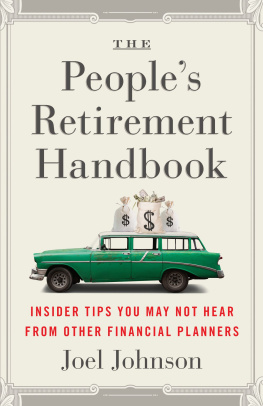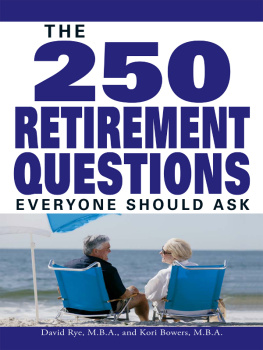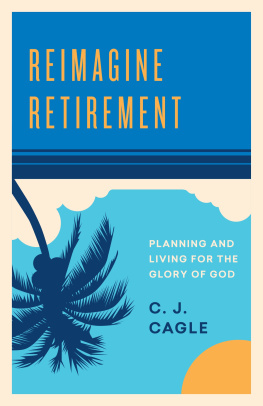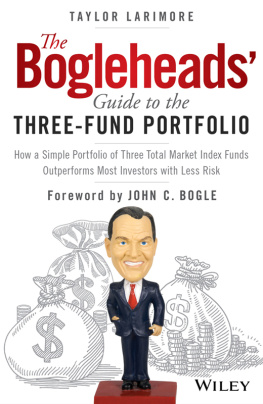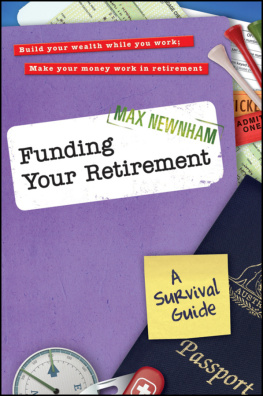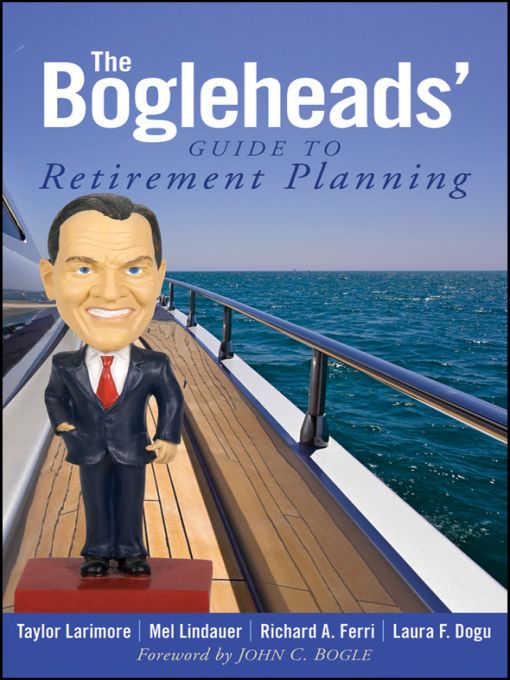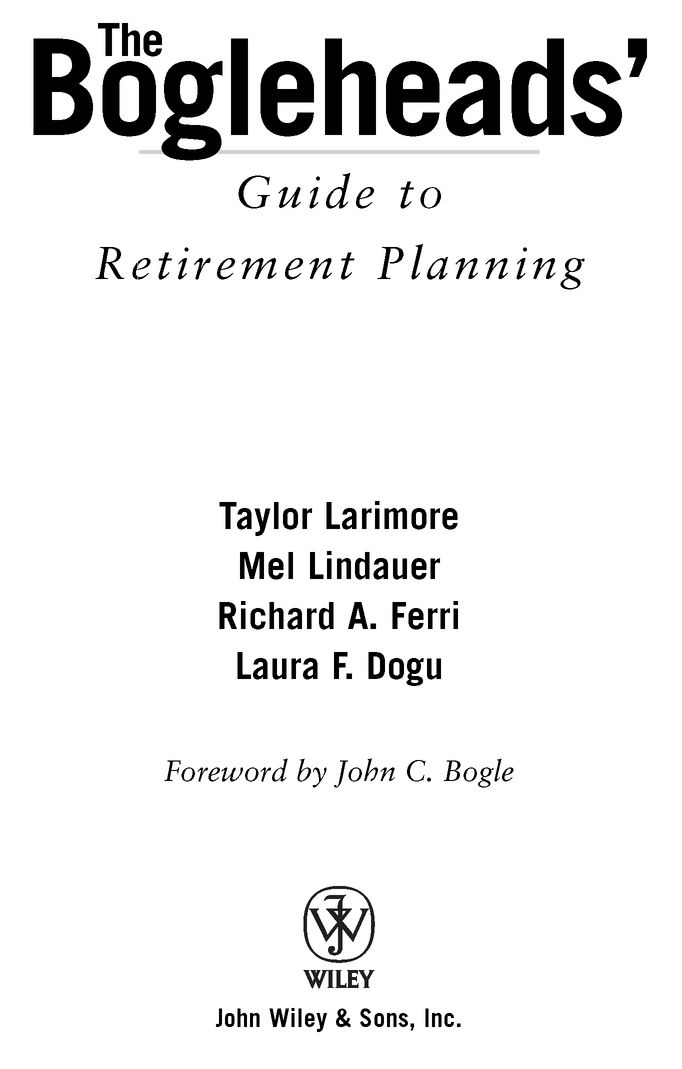Table of Contents
ADDITIONAL PRAISE FORTHE BOGLEHEADS GUIDE TO RETIREMENT PLANNING
If youre interested in funding your own retirement rather than some
Wall Streeters retirement, this is the book for you. Read it cover to cover
and youll end up knowing more than 90 percent of financial professionals.
Hats off to the Bogleheads for the great service they have done for
consumers with this book.
Allan S. Roth, CFP , CPA, MBA,
Author of How a Second Grader Beats Wall Street
To find true financial joy, you need to integrate sound financial principles
into your life. Retirement is an opportunity to live the life you
always dreamed ofbut only for the prepared. Thats where the Bogleheads
shine. You can always count on them for straight talk, thoughtful
commonsense commentaries, and a willingness to help others. We can all
learn from their grassroots, solid approach to retirement planning that is
consistently supplemented with the powerful, rich conversations that take
place every day at www.bogleheads.org.
Sue Stevens, President,
Stevens Wealth Management LLC and
Financial Happiness LLC
This book is dedicated to John C. Bogle.
For his wisdom, kindness, and unselfish devotion to helping individuals achieve their dreams.
All royalties from the sale of this book are being donated to:The National Constitution Center
Philadelphia, PA
Foreword
Its hard to imagine a more fortuitous time to write a guide to retirement planning. The global financial crisis and the recession and bear market it has brought in its wake have exposed the tenuous condition of the retirement savings of millions of Americans, who would undoubtedly benefit from the sort of advice the Bogleheads dispense in this book.
On the other hand, its also hard to imagine a time when investors might be more reluctant to read anything that has to do with investing. Their nest eggs often depleted and sometimes shattered, and dreams of retirement delayed if not deferredlargely due to the recklessness of a select group of Wall Street experts who seemed unable to measure the risks on the balance sheets of the firms they ranone could hardly blame an investor who says the heck with it all, writing off the financial markets as a rigged game, one in which their capital is used, first and foremost, to enrich the insiders.
But the fact that such a reaction is understandable doesnt make it correct. For better or worse, most Americans today who want to enhance the modest retirement income distributed through our Social Security system have been given the responsibility of funding and managing their own retirement accounts, charged with investing their way to a secure financial future. The current economic crisis will not absolve us of that responsibility, even as it makes it more difficult. Invest we must.
But that by no means implies that investors should continue blithely along the path theyd been on. As the current bear market has made plain, too many Americans were ill-prepared to shoulder the responsibility that had been placed upon them. Even worse, our mutual fund industry was equally incapable of providing the assistance our nation of amateur investors needed. The conflicts of interest mutual fund managers faceseeking to maximize their own earnings, which reduce, dollar for dollar, the returns earned by their mutual fund investorsproved too great a temptation for them to resolve in favor of their fund investors.
So what is an investor to do? First and foremost, seek wisdom. Wisdom excelleth folly as far as light excelleth darkness. I used those words from Ecclesiastes some 15 years ago, in the epilogue of my first book, Bogle on Mutual Funds, as a way of introducing my Twelve Pillars of Wisdom, which I described as lamps to guide you on your search for a sensible, productive investment program.
Reviewing them recently, I was struck by how well they have stood the test of time. Ill let you judge for yourself:
1. Investing is not nearly as difficult as it looks. Successful investing involves doing just a few things right and avoiding serious mistakes.
2. When all else fails, fall back on simplicity. There may be a handful of alternatives that prove to be better than simply buying and holding a portfolio balanced equally between a total stock market index fund and a total bond market index fund over the long term, but the number of alternatives that will prove to be worse is infinite.
3. Time marches on. The majesty of compounding returns is remarkable. Over 25 years, an 8 percent annual return grows a $10,000 investment by $58,500. But the tyranny of compounding costs is remarkably destructive. Annual costs of 2.5 percent would reduce that return to 5.5 percent and slice your portfolios long-term growth by more than half, to $28,100.
4. Nothing ventured, nothing gained. Yes, the stock market is volatile. Yes, its future returns are unknown. But eschewing the stock market incurs its own risks. Our recognition of that and our faith in the resiliency of American capitalism compel the majority of American investors to allocate at least some portion of their nest egg to stocks in an effort to reach their long-term goals.
5. Diversify, diversify, diversify. While its impossible to eliminate all of the risk associated with investing, risk can be greatly reduced by diversifying broadly within each asset class (ideally, using a low-cost total market index fund) and then constructing a well-balanced portfolio that owns an appropriate mix of stocks and bonds.
6. The eternal triangle. Risk, return, and cost are the three sides of the eternal triangle of investing, inextricably linked to the long-term growth of your portfolio.
7. The powerful magnetism of the mean. Investment superstars come and go, the vast majority proving to be comets who briefly illuminate the firmament with spectacular performance, only to see their returns deteriorate, returning to, and then lagging, the average returns of their peers and the market.
8. Dont overestimate your ability to pick superior equity mutual funds, nor underestimate your ability to pick superior bond and money market funds. In equity funds, past returns tell us nothing about what the future holds. Performance comes and goes, and yesterdays leaders are likely to be tomorrows laggards. The top-performing bond and money market funds, on the other hand, are typically populated by the lowest-cost alternatives. In these areas, investors can choose the low-cost leaders with a reasonable amount of confidence in their favorable prospects for continued success.
9. You may have a stable principal value or a stable income stream, but you may not have both. Intelligent investing involves choices, compromises, and trade-offs, perfectly illustrated by the choice between a 90-day Treasury bills fixed value and volatile income stream, on one hand, and a long-term Treasury bond funds volatile market value and relatively stable income stream on the other.
10. Beware of fighting the last war. Too many investorsindividuals and institutions alikebecome infatuated with the recent past and find themselves eternally (and futilely) reacting to what has happened in the financial markets instead of building a portfolio that can withstand whatever the future holds, recognizing that particular cycles and trends never last forever.



